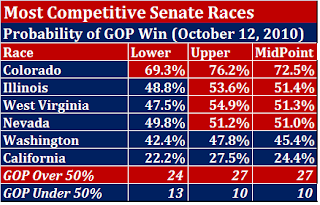Post is a little late: Have to admit I had to take the time to watch the first miner emerge in Chile. Certainly an uplifting moment.
Republican prospects in the House of Representatives took a step forward in today's data run as the probability of a House Republican takeover pierced the 80% level. The midpoint range of our seat estimate is 231 which would represent a 54 seat increase from the 177 Republicans held after the 2008 elections.
On the Senate side of the ledger Democrats produced a small, but significant comeback in today's analysis. (It is worth noting that the data was extremely volatile today and our data run represents a snapshot of data at about 9 P.M. EDT today.)
The midpoint, or median, estimate of our macro model forecasts 49.5 Republican seats; the micro model forecasts 48.1%. The macro model currently projects the probability of a Republican takeover of the Senate as 26.8%.
As I mentioned there were several changes in individual races from yesterday. As the table to the left illustrates, if our lower end estimate in all races proved to be the outcome, Republicans would fall four seats short, while at the upper end estimate they would fall one seat short.
Remember the markets are extremely volatile at this point in time and it is not unusual to see large one day swings in the data. The question is whether this is a new trend or simply a one or two day correction. To know that, we'll have to wait for a few more days worth of data.
Today's data does provide the opportunity to give an illustration of conditional probabilities and how they could be affected as events unfold on election day.
Let's take the hypothetical situation where four races (West Virginia, Washington, Illinois, and Nevada) are the races that will determine Senate control. From a straight statistical standpoint the probability of Republicans winning all four is 6% -- using our median probability estimate in the races AND assuming they are independent events.
As you watch on election night, as each race is decided this probability will change. The table at the left shows how the probability of Republican control would change based on results becoming known in the individual races. As I said, this is hypothetical and is unrealistic from a time perspective, but is intended to provide an example. If Republicans win West Virginia, then the probability of control would increase to 12%. If the next state to be decided in the Republicans favor were to be Washington, Republicans chance of control would increase to 26%. With two races remaining, the news arrives that Republicans have won Illinois and only Nevada is outstanding, then Republicans chances of winning the Senate become 51%.
We hope to be able to blog updated probabilities throughout the evening on election night as races are decided. This will vary from the example above not only by order (and perhaps states), but by race probabilities as well. For instance if Republicans were to score an early and sizeable victory in West Virginia, that would likely alter market participant views of other races. Conversely, a quick Democratic win, would likely see probability declines for Republicans in other races.
Regardless of how successful we are in live blogging election night, we will have much more to say about scenarios and how to track election night probailities as the returns come in.
If you have any questions or suggestions for topics please email us at electionmarkets@gmail.com. And I encourage you to let others know about this site. At the end of this week we will be posting our first online poll -- if the President and Vice President choose to watch a movie on election night instead of the returns, what will it be. The list is about complete, but email us any suggestions for movies to include.



